CRY!BOYS AND INDIANS
Let’s be honest: Director Elizabeth LeCompte’s sometimes astonishing adaptation of Shakespeare’s Trolius and Cressida by the acclaimed Wooster Group of New York is indeed a bit of a misstep. On the other hand, it is a simply brilliant failure. The show crackles with ferociously presented and compelling ideas; gorgeously visual stagecraft; and unique twists and tricks that turn dear old Shakespeare’s 1602 tragedy right on its ear where it belongs.
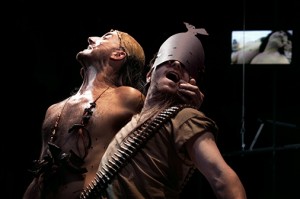 On yet another hand, what doesn’t leave your jaw dropping with amazement will have your eyes crossing with confusion and rage. Sometimes theater must indeed challenge and surprise to be effective—and sometimes a work’s risks don’t exactly work out; that’s why it’s risky. But what a beautiful mess this is!
On yet another hand, what doesn’t leave your jaw dropping with amazement will have your eyes crossing with confusion and rage. Sometimes theater must indeed challenge and surprise to be effective—and sometimes a work’s risks don’t exactly work out; that’s why it’s risky. But what a beautiful mess this is!
Before one can even start to “get” this production, a great deal of backstory is required. In 2012, the Royal Shakespeare Company of Great Britain contracted with the Wooster Group to put on a sort of co-production of Trolius and Cressida. For those who don’t know the play, the story takes place during the Trojan War, and centers on the ill-starred romance between Trojan lovers Trolius and Cressida, while all around them evil Greeks Ulysses and Achilles plot to slaughter Trojan warrior Hector.
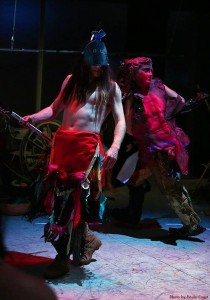 For this production, the RSC performers would play the Ancient Greeks (directed by Brit theater wunderkind Mark Ravenhill). The Trojan characters would be portrayed by actors in the Wooster Group, in a staging directed by Wooster artistic director LeCompte. The two “sides” rehearsed separately—the Woostertrojans in New York and the Greekyroyals in England—and they only came together as the show was ready to open as part of the 2012 London Olympic Arts Festival.
For this production, the RSC performers would play the Ancient Greeks (directed by Brit theater wunderkind Mark Ravenhill). The Trojan characters would be portrayed by actors in the Wooster Group, in a staging directed by Wooster artistic director LeCompte. The two “sides” rehearsed separately—the Woostertrojans in New York and the Greekyroyals in England—and they only came together as the show was ready to open as part of the 2012 London Olympic Arts Festival.
The production was reportedly a train wreck, with the two casts’ incredibly different acting styles and the two directors’ different presentational motifs being almost ridiculously incapable of integrating with each other. The Royals played their Greeks as effete European decadents, in standard Patsy Rodenberg style, all arms-a-waving and strutting iambic plumminess. The Woosters portrayed the Trojans as Native American heroes and as edgy, artistic outlaws. The Royals orated from their diaphragms, while the Woosters howled using wraparound microphones. How I wish I could have seen it! One possibly could have giggled for hours and hours.
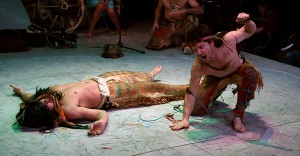 Now, in the touring production playing at REDCAT, we are treated to a streamlined and adapted version of the production that downplays the RSC elements and instead focuses on the travails of the Trojans. It is a joy to watch, even though it is also incomprehensible to the point of being unadulterated nonsense. Scott Shepherd (Gatz) plays the role of Trolius as proud Native American warrior, replete with long black hair and beaded headband. He speaks his verse, as all the cast’s Greek characters do, in the sort of flat, uninflected tones of the Great Plain Indians. Between lines, he sometimes dances and chants and smokes a peace pipe.
Now, in the touring production playing at REDCAT, we are treated to a streamlined and adapted version of the production that downplays the RSC elements and instead focuses on the travails of the Trojans. It is a joy to watch, even though it is also incomprehensible to the point of being unadulterated nonsense. Scott Shepherd (Gatz) plays the role of Trolius as proud Native American warrior, replete with long black hair and beaded headband. He speaks his verse, as all the cast’s Greek characters do, in the sort of flat, uninflected tones of the Great Plain Indians. Between lines, he sometimes dances and chants and smokes a peace pipe.
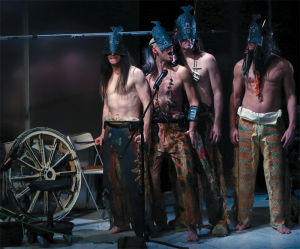 Kate Valk’s Cressida is styled as Pocahantas, with long pony tail braids and a leather fringed skirt. When she and Greg Mehrten’s delightful Pandarus (imagine a Native American Paul Lynde, with nasally, snarky speech patterns interspersed with Apache yips and yowls) hide behind a tipi to watch the warriors arrive in a sort of huge tribal war dance, the sight is almost hard to describe. Scenes in which the Trojan characters hold a war council are rendered as a pass-the-peace pipe ceremony. (Let us set aside for the moment the all-too-understandable kerfuffle over the fact that none of the actors appear to be Native American: They’re all Caucasians, dressed in cowboy movie Injun Drag, which one can easily imagine being potentially offensive.)
Kate Valk’s Cressida is styled as Pocahantas, with long pony tail braids and a leather fringed skirt. When she and Greg Mehrten’s delightful Pandarus (imagine a Native American Paul Lynde, with nasally, snarky speech patterns interspersed with Apache yips and yowls) hide behind a tipi to watch the warriors arrive in a sort of huge tribal war dance, the sight is almost hard to describe. Scenes in which the Trojan characters hold a war council are rendered as a pass-the-peace pipe ceremony. (Let us set aside for the moment the all-too-understandable kerfuffle over the fact that none of the actors appear to be Native American: They’re all Caucasians, dressed in cowboy movie Injun Drag, which one can easily imagine being potentially offensive.)
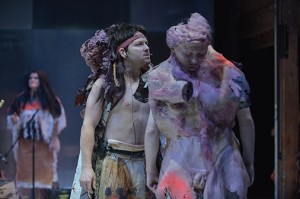 On almost all levels, the conceit of having the Trojan characters played as Native Americans comes across as half-baked and downright weird. But that’s just a taste of the show’s oddness. The production boasts a certain “couldn’t give a rat’s ass” attitude that’s frequently fresh and rather dangerous—you really don’t know what’s going to happen next.
On almost all levels, the conceit of having the Trojan characters played as Native Americans comes across as half-baked and downright weird. But that’s just a taste of the show’s oddness. The production boasts a certain “couldn’t give a rat’s ass” attitude that’s frequently fresh and rather dangerous—you really don’t know what’s going to happen next.
Scenes are acted in front of video monitors showing what appears to be Inuit Eskimos acting out the same scenes somewhere in the Tundra. The onstage characters dance and fight with lacrosse paddles that are tipped with bayonet knives, and they wear “armor” that consists of Styrofoam models of the Venus de Milo 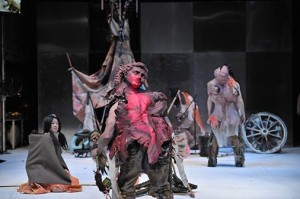 statue; it makes no sense at all. A pair of onstage sound mixers amplifies the spoken dialogue, interspersing it with chants and pulsing drumbeats; Bruce Odland’s design is a marvel.
statue; it makes no sense at all. A pair of onstage sound mixers amplifies the spoken dialogue, interspersing it with chants and pulsing drumbeats; Bruce Odland’s design is a marvel.
When the play’s Greek characters appear, they’re played by the Trojan characters in masks. Meanwhile, a recording of the RSC production’s pontificating actors is played in the background, with the onstage actors hamming it up like they’re playing a mean-spirited joke on the “conventional” actors. Either that or they are engaging in a sort of mystical Native American ritual involving the subsuming of their enemies. It’s fascinating and stagy, if mystifying.
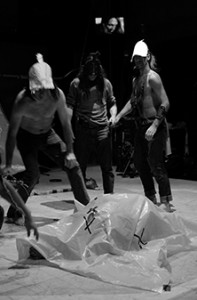 Ultimately, though, the conceits are awkwardly and distractingly shoehorned into the production, which tends to falter on the more conventional theatrical level. This is the level LeCompte & Co. appear to have very little patience for. The romantic chemistry between Shepherd’s Trolius and Valk’s Cressida is tepid at best (part of the problem is that the staging calls for them to punch each other in the face when they’re supposed to kiss; it might be a metaphor for power in a relationship or it could just be an excuse for Odland to play his “thump-thump” machine again). In addition, the Shakespearean line readings are mauled and ignored in favor of the unnatural accent. Still, these tremendous reservations aside, it’s hard to imagine a more intriguing and downright deranged production. If you don’t mind your Shakespeare totally unhinged, this is a fine show to see.
Ultimately, though, the conceits are awkwardly and distractingly shoehorned into the production, which tends to falter on the more conventional theatrical level. This is the level LeCompte & Co. appear to have very little patience for. The romantic chemistry between Shepherd’s Trolius and Valk’s Cressida is tepid at best (part of the problem is that the staging calls for them to punch each other in the face when they’re supposed to kiss; it might be a metaphor for power in a relationship or it could just be an excuse for Odland to play his “thump-thump” machine again). In addition, the Shakespearean line readings are mauled and ignored in favor of the unnatural accent. Still, these tremendous reservations aside, it’s hard to imagine a more intriguing and downright deranged production. If you don’t mind your Shakespeare totally unhinged, this is a fine show to see.
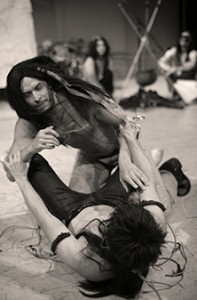 photos by James Allister Sprang, Paula Cort,
photos by James Allister Sprang, Paula Cort,
and Hugo Glendinning
Cry Trojans! (Troilus and Cressida)
Wooster Group at REDCAT
Walt Disney Concert Hall
scheduled to end on March 9, 2014
for tickets, call 213-237-2800
or visit www.REDCAT.org
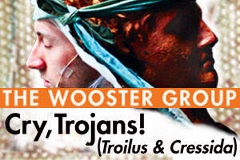
{ 1 comment… read it below or add one }
The Indians/Trojans are cartoonish and their ritual dancing is more like the Soupy-Shuffle than anything authentic. The English/Greeks also come across as caricatures. The only Woosterish rationale that I can think of behind this approach is to suggest that our apprehension of the Trojan War is like a comic book and interpreted through filmic images and flat text.